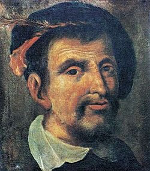|
Columbus's Son's Lost Library Catalog Found 500 Years Later
April 25, 2019
A very large library thought lost to history lives on in the pages of its catalog. The library was the labor of love of Hernando Colón, whose father was the famed explorer Christopher Columbus. Colón, born when Columbus was waiting for funding to finance his first voyage to the New World, decided to take a different path from that of his father. He wanted to build the world's largest library. Columbus became quite rich for a time after his return from the New World, and he shared some of those riches with his family. Colón used the money to finance his project, traversing the great cities of Europe looking for more additions to his collection: books, pamphlets, music scores, anything printed that he thought interesting. In the end, his library included more than 15,000 books and more than 3,000 prints and drawings. Realizing that he wouldn't have time to read all of the books in his library, he paid a group of other people to do it for him and then write summaries, which he collected in the medieval equivalent of a catalog, titled Libro de los EpÍtomes. It contained summaries of more than 2,000 books. (The original contained only 3,500 summaries; Colón collected faster than this staff could summarize.) Colón died in 1539, much of his collection did not survive, and the catalog went missing. It was recently rediscovered in a collection at the Arnamaganæan Collection at the University of Denmark, in Copenhagen. That collection has mostly Icelandic-language books, and Libro de los EpÍtomes was written in Latin, so it didn't really fit in with the other books in the collection and so was likely ignored. In fact, historians know that the man who bought Colóln's catalog, Arni Magnusson, took it because it was lumped in with a group of books that he really wanted. Magnusson bequeathed his book collection to the university on his death. Guy Lazure, a scholar at the University of Windsor in Canada, first identified the book and its connection to Colón while doing research on the Magnusson collection and had his hunch verified by officials at the Metropolitan Museum of Art in New York and by the authors of a biography of Colón. Plans are for the catalog to be digitized and translated into other languages. Colón was an obsessive collector. He also had, at the time, the largest collection of printed images in the world and also the largest collection of printed music in the world. He started work on a dictionary but had taken up more than 1,400 pages before getting to the letter C. He never finished it. He also left unfinished a geographical encyclopedia of Spain, containing more than 6,600 entries. Colóaccompanied his father on his last voyage to the New World, the one that resulted in the famous explorer's being shipwrecked for a year. Son spent that time getting to know his father better and eventually wrote his biography. As for the library, Colón bequeathed it to a nephew, who mostly abandoned it. Whatever was left–about a quarter of the original contents–made its way to Seville Cathedral in 1522 and has been there since. |
|
Social Studies for Kids
copyright 2002–2024
David White







